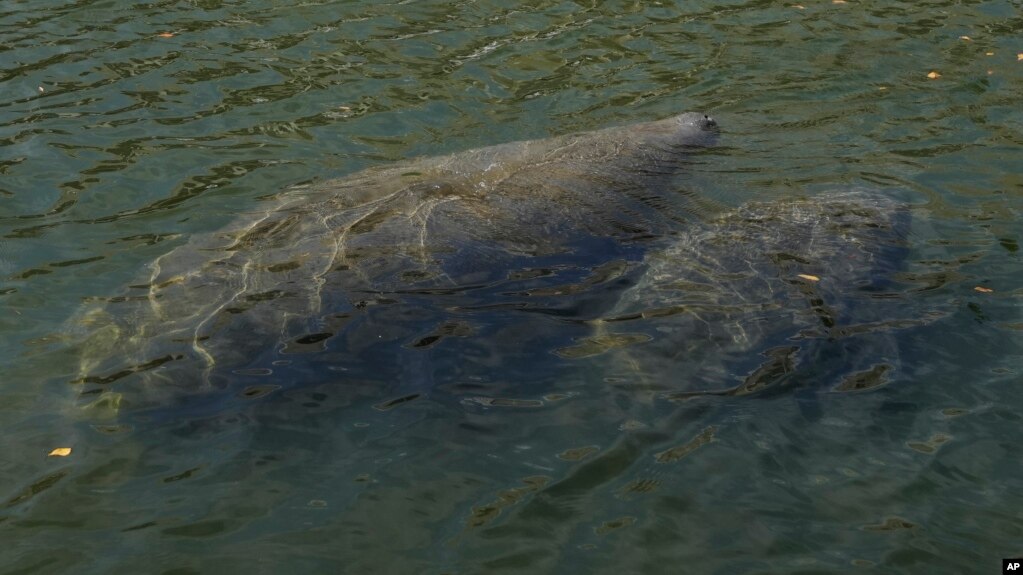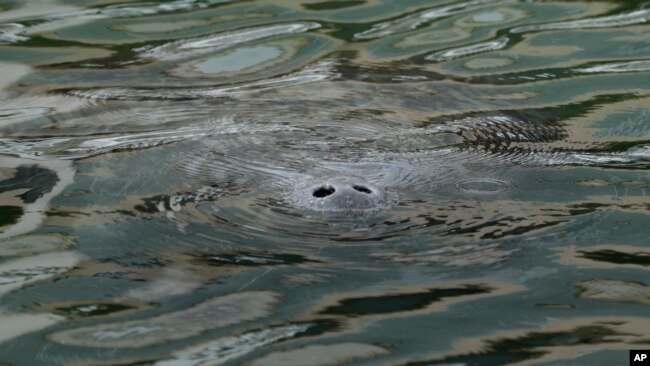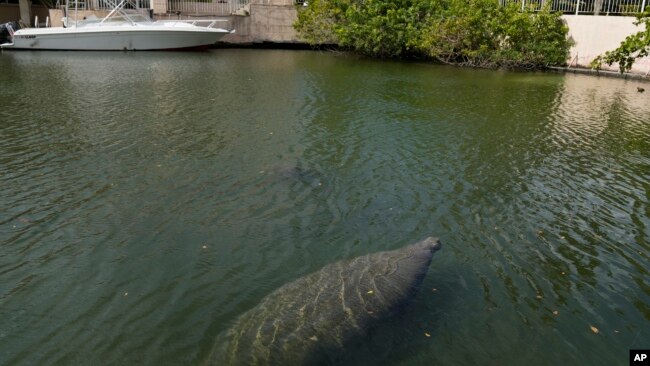
An adult and young manatee swim together in a canal, Wednesday, Feb. 16, 2022, in Coral Gables, Fla. (AP Photo/Rebecca Blackwell)
Florida wildlife officials say manatees facing starvation are benefitting from a program that feeds them tons of donated lettuce.
The program aims to save as many of the large animals as possible as water pollution led to shortages of their favorite food, seagrass.
Officials say the human-caused pollution results from activities related to agriculture, waste from cities and other causes.
The United States Fish and Wildlife Service oversees the feeding program, which is carried out near a Florida Power & Light power center on Florida’s central-east coast. So far, the effort has provided the manatees with more than 25 tons of lettuce.
Officials say the feedings usually draw about 300 to 350 manatees per day. Sometimes, as many as 800 show up.

“We’re making a difference,” said Ron Mezich, from Florida’s Fish and Wildlife Conservation Commission. He spoke recently during an online news conference about the program. “It gives us the greatest exposure to the greatest number of animals,” he said.
Last year, a record 1,101 manatee deaths were reported, largely from starvation. The normal five-year average is about 625 deaths. State wildlife officials say that so far this year, 164 manatee deaths have been recorded.
Tom Reinert is the local director of the state’s Fish and Wildlife Conservation Commission. He is also a spokesman for the state-federal effort to save manatees. Reinert said the feeding program has helped to reduce the rising death rates. “We are adjusting our program to get as much food to manatees as we can.”
Normally, wildlife experts advise against people feeding wild animals. This is because it can lead the animals to make an unhealthy connection between humans and food. It is a crime in Florida for a person to feed manatees on their own, even though officials say many people want to do so.

Reinert believes the best ways people can help are to donate money, through an official organization, or to report any sick or struggling animals. “Feed them with your dollars,” he said.
Officials estimate there are about 8,800 manatees in Florida waters. That is a big improvement from about 2,000 that existed in the 1990s. The increased numbers were responsible for manatees being removed from a federal endangered list. Currently, they are listed as threatened.
Reinert said that even with the most recent die-off, there is only about a 1 percent chance of manatees disappearing in the wild. The most important element for supporting the remaining population will be restoring seagrass beds, he added. So far, Florida has set aside $8 million to deal with that problem.
“You can’t just go out and plant a bunch of seagrass,” Reinert said. But, he added, “projects are getting started and are in the planning stages.”
I’m Bryan Lynn.
The Associated Press reported on this story. Bryan Lynn adapted the report for VOA Learning English.
We want to hear from you. Write to us in the Comments section, and visit WWW.VOA-STORY.COM
___________________________________________________
Words in This Story
benefit – v. to be helped by something
exposure – n. the condition of being presented of made known
adjust – v. to change something so that it works or fits better
restore – v. to make something good exist again
bunch – n. a number of things of the same kind that are joined or held together
stage – n. a period of development or a particular time in a process